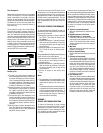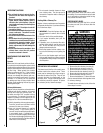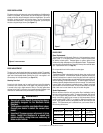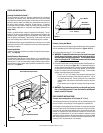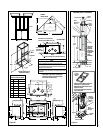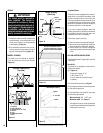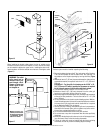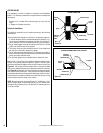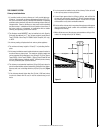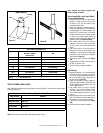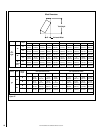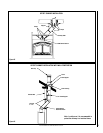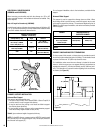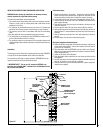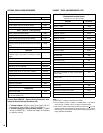
8. A rain cap must be installed on top of the chimney. Failure to install
a rain cap may cause corrosion problems.
9. Cut and frame square holes in all floors, ceilings, and roof that the
chimney will go through to provide a 2” (50 mm) clearance between
the chimney and any combustible materials. Do not fill this 2” space
with insulation or any other combustible material.
10. Portions of the chimney which may extend through accessible spaces
must be enclosed to avoid contact with combustible materials or
damage to the chimney.
11.When offsets are used, the pipe may not penetrate a ceiling or floor
unless it is running vertical (no 30° offsets).
Figure 21
THE CHIMNEY SYSTEM
Chimney Installation Notes
1. If possible, install an interior chimney as it will provide better per-
formance. In areas with continuous temperatures below 18°C (0°F),
the use of an exterior chimney increases the likelihood of operating
problems such as low draft, high rate of creosoting, and poor start-up
characteristics. Exterior chimneys are also prone to down-drafting
and flow reversal. Installations which are located on lower floors in
the house, such as in a basement, in combination with an outside
chimney, are especially prone to flow reversal.
2. The fireplace model MONTEST
may be installed only with Security
Chimneys International Ltd 7” dia. chimney systems model Secure
Temp™
S2100+ / Nova Temp™
HT6000 / Secure Temp GX (U.S. only)
or ACBI.
3. A chimney venting a fireplace shall not vent any other appliance.
4. The minimum chimney height is 12 feet (3.7 m) excluding the fire-
place.
5. All chimney installations must include at least one support in order to
be able to take any lateral load. The maximum chimney length that
can be supported by the fireplace is nine (9) feet (2.75 m) for Secure
Temp
S2100+ / Nova Temp
HT6000+ / Secure Temp
GX and 26 feet
(8m) for ACBI chimney. In altitude, add 18” (450 mm) to the chimney
for every 2,000 feet (600 m) above sea level.
6. The chimney must extend at least three (3) feet (915 mm) above its
point of contact with the roof and at least two (2) feet (610 mm) higher
than any wall, roof or building within ten (10) feet (3 m) of it (Figure
21).
7. If the chimney extends higher than five (5) feet (1,500 mm) above
its point of contact with the roof, it must be secured using a roof
brace.
ten (10) feet
three (3) feet Min.
two (2) feet Min.
NOTE: DIAGRAMS & ILLUSTRATIONS ARE NOT TO SCALE.
13



